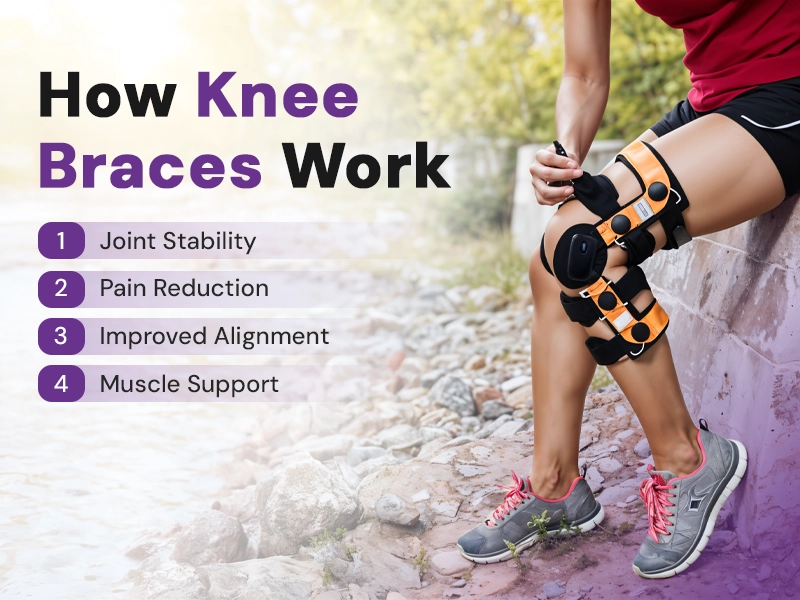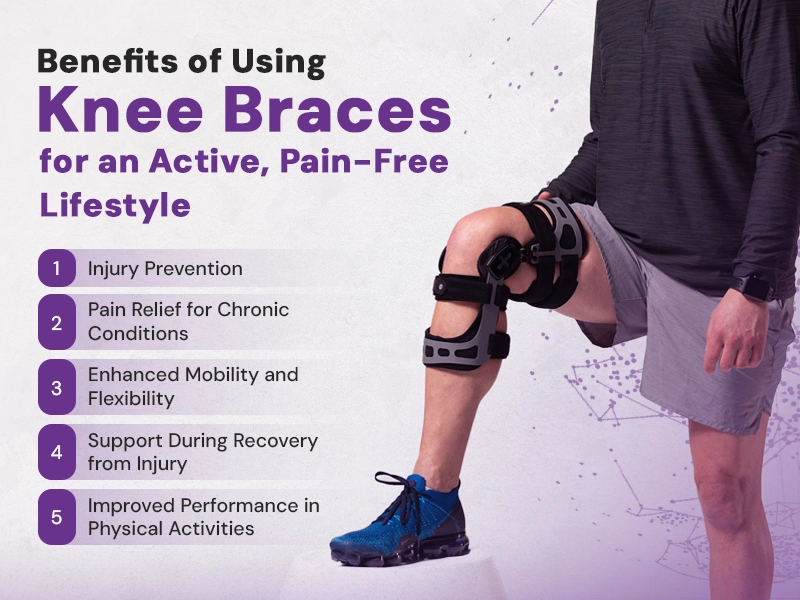
Introduction
Knee pain can be a significant barrier for anyone leading an active lifestyle. From runners and hikers to athletes and everyday walkers, knee discomfort can limit mobility and disrupt daily activities. Thankfully, knee braces provide an accessible solution to manage pain, support movement, and reduce the risk of injury, helping you stay active and pain-free.
Knee braces are designed to stabilize the knee joint, alleviate pressure on the ligaments, and support the surrounding muscles. Whether you’re recovering from an injury or simply want to protect your knees during exercise, a knee brace can be an essential part of your routine. In this guide, we’ll explore how knee braces work, the types available, and how they can help you enjoy your activities without pain.
How Knee Braces Work

Knee braces provide external support to the knee joint, which is one of the most complex and commonly injured joints in the body. They work by stabilizing the knee, reducing strain on the ligaments, and offering controlled movement. Here are some of the ways knee braces support knee health:
- Joint Stability: Knee braces enhance joint stability, reducing the risk of wobbling or overextension, especially useful during activities that involve sudden changes in direction or impact. For individuals recovering from ligament injuries, such as ACL tears, this added stability allows the knee to heal while remaining protected, enabling safe movement and preventing re-injury.
- Pain Reduction: Knee braces help distribute pressure evenly across the joint, which can alleviate pain from specific areas affected by conditions like arthritis or patellar tracking issues. This even distribution helps reduce strain on sensitive areas, allowing for greater comfort during activities and providing relief without excessive reliance on painkillers.
- Improved Alignment: Braces gently guide the knee into a natural position, preventing the joint from twisting or turning incorrectly. This is particularly helpful for high-impact activities, where proper alignment helps protect the knee from unnecessary strain and promotes healthier movement patterns, which benefits not only the knee but also surrounding muscles and joints.
- Muscle Support: With gentle compression around the knee, braces reduce muscle fatigue by improving blood flow and relieving strain on surrounding muscles. This allows for extended activity with less discomfort, as the muscles work in harmony with the brace to support the knee, which is especially beneficial during long walks, runs, or recovery phases.
Benefits of Using Knee Braces for an Active, Pain-Free Lifestyle

Knee braces provide a range of benefits that can help you stay active, mobile, and comfortable. Here are the primary advantages of using a knee brace:
1. Injury Prevention
For athletes and active individuals, preventing knee injuries is essential to maintaining long-term joint health. Knee braces, particularly functional and prophylactic braces, are designed to protect the knee by providing lateral support and limiting movements that could damage ligaments. This is especially valuable for sports that require quick directional changes, such as basketball, soccer, or skiing, where twisting or sudden impact can strain or tear ligaments like the ACL.
Tip: If you’re prone to knee injuries or play high-impact sports, consider a brace specifically designed for injury prevention. This extra support can provide the reinforcement needed to maintain stability under intense movement, reducing the risk of sidelining injuries.
2. Pain Relief for Chronic Conditions
Knee braces are particularly beneficial for individuals managing chronic knee pain due to conditions like osteoarthritis, patellar tendinitis, or cartilage wear. By redistributing the load on the knee joint, braces help alleviate pain, allowing users to stay active without exacerbating their discomfort. Compression braces, for example, reduce inflammation and swelling, which can relieve symptoms associated with chronic pain conditions, enabling a better range of motion and reduced stiffness.
Tip: For chronic knee pain, choose a brace with adjustable compression to tailor the level of support. Adjusting the compression allows you to fine-tune relief based on your daily activities and pain level, making it easier to maintain an active lifestyle with less discomfort.
3. Enhanced Mobility and Flexibility
One of the biggest advantages of knee braces is their ability to enhance mobility by stabilizing the knee joint. This stability minimizes unnecessary movement, making activities like walking, running, or even climbing stairs easier and safer. For individuals with knee instability or weakness, this added support reduces the risk of sudden, sharp pain, providing greater confidence to engage in activities they might have previously avoided. This is especially helpful for those recovering from knee injuries, as it allows them to regain confidence in movement.
Tip: For activities requiring a full range of motion, select a lightweight or low-profile brace that supports the knee without restricting movement. A properly fitted brace can offer the right blend of stability and flexibility, helping you enjoy a wide range of activities comfortably.
4. Support During Recovery from Injury
Knee injuries require patience and cautious movement to heal effectively, and knee braces play a vital role in this recovery process. Post-surgical braces and rehabilitative knee braces are designed to restrict movement in controlled increments, ensuring that the knee can heal without unnecessary strain. For minor injuries, knee braces provide support during physical therapy exercises, preventing re-injury while the knee gradually builds strength.
Tip: Follow your healthcare provider’s instructions on the specific brace type and wear duration to ensure safe recovery. Wearing the brace as directed will protect the knee from excessive strain, aiding in a smoother recovery journey and reducing the likelihood of reinjury.
5. Improved Performance in Physical Activities
For athletes and fitness enthusiasts, knee braces can enhance performance by providing essential stability and reducing muscle fatigue. By offering targeted support to the muscles around the knee, braces help maintain endurance during prolonged activities, allowing users to train longer without compromising safety. This added stability also enables athletes to focus on movement quality, ensuring that each step or jump is fully supported.
Tip: For high-performance sports, select a brace that’s designed for dynamic movement, such as a compression sleeve or a lightweight stabilizing brace. These types offer the necessary support without restricting flexibility, letting you perform at your best with minimized risk of injury.
Read More: The Ultimate Guide to Choosing the Right Ankle Brace for Injury Recovery
Types of Knee Braces
There are several types of knee braces, each designed to address specific support needs and activity levels. Understanding these options will help you choose the right brace for your lifestyle and health requirements:
- Prophylactic Braces: Primarily used in contact sports like football and basketball, prophylactic braces are designed to protect the knee from injury by providing external support to the ligaments. These braces help prevent injuries like ACL and MCL tears, making them a popular choice among athletes who frequently experience high-impact or collision-based movements.
- Functional Braces: Functional braces are ideal for individuals recovering from knee injuries, such as ligament tears or strains. These braces offer stability and allow controlled movement, supporting the knee during rehabilitation. Functional braces are perfect for those looking to gradually return to activity, as they protect the knee from re-injury while restoring strength and mobility.
- Rehabilitative Braces: Often prescribed post-surgery or after severe injuries, rehabilitative braces limit knee movement to prevent strain and aid in the healing process. These braces are typically adjustable, allowing for restricted movement at various angles as recovery progresses. Rehabilitative braces are crucial during the initial stages of recovery, giving the knee time to heal while minimizing the risk of further damage.
- Unloader Braces: Designed specifically for individuals with arthritis, unloader braces help relieve knee pain by redistributing weight away from the affected areas of the knee joint. This weight-shifting function reduces pressure on the knee, alleviating discomfort and enabling arthritis sufferers to remain active with less pain. Unloader braces can make daily activities, like walking or climbing stairs, more manageable for those with chronic knee pain.
- Compression Sleeves: Offering mild support, compression sleeves are lightweight and ideal for reducing swelling, improving circulation, and providing general support. These braces are commonly used for managing mild knee pain, and they’re perfect for low-impact activities like walking or light exercise. Compression sleeves are also discreet and comfortable enough for all-day wear, making them a versatile option for daily use.
By choosing the appropriate type of knee brace, you can enjoy tailored support that meets your specific needs, whether it’s for daily activities, athletic performance, or injury recovery.
How to Choose the Right Knee Brace for Your Needs
Selecting the right knee brace depends on your specific condition, activity level, and desired support. The right brace will enhance both comfort and performance, so it’s essential to choose one that aligns well with your needs. Here are some factors to consider:
- Support Level: Determine whether you need mild, moderate, or strong support. For daily activities or low-impact exercises, a compression sleeve that provides mild support may be sufficient. For sports, injury recovery, or if you need extra stability, consider a brace with more substantial support to protect and reinforce the knee during movement.
- Material and Comfort: Choose breathable materials like neoprene or mesh to prevent sweat buildup and skin irritation, especially if you plan to wear the brace for long hours. Breathable fabrics keep your skin cool and dry, enhancing comfort for all-day wear.
- Adjustability: Opt for knee braces with adjustable straps or closures, allowing you to personalize the fit for maximum comfort and support. This customization helps maintain effective compression while preventing the brace from slipping or feeling too tight.
- Activity Type: Consider the level of movement involved in your activities. For high-impact sports or dynamic movements, choose a brace that offers a full range of motion along with stability. For lighter activities or posture correction, a more flexible brace may provide just the right balance of mobility and support.
By considering these factors, you can select a knee brace that enhances your comfort, safety, and performance, making it easier to stay active and pain-free.
Ready to Support Your Knees?
Knee braces are designed to fit seamlessly into an active lifestyle, providing the support you need to stay active, relieve pain, and prevent injury. Whether you’re jogging, hiking, engaging in sports, or simply enjoying daily walks, the right knee brace can help keep you comfortable, mobile, and confident in every step. With options suited for different activity levels and support needs, choosing a brace that meets your specific requirements can make a significant difference in maintaining a pain-free, active lifestyle. Find the right fit for your needs and keep moving forward—stronger and pain-free.
Conclusion
Knee braces offer a valuable solution for anyone looking to stay active and pain-free. Whether you’re managing chronic pain, recovering from an injury, or simply looking to prevent strain during exercise, a knee brace can make a significant difference. By providing stability, reducing strain, and promoting natural movement, knee braces help you maintain an active lifestyle with confidence and comfort.
Choosing the right brace is essential for optimal results, so be sure to select one that meets your specific needs and provides the appropriate level of support. With the right knee brace, you can enjoy your favourite activities with less pain and more freedom of movement.
